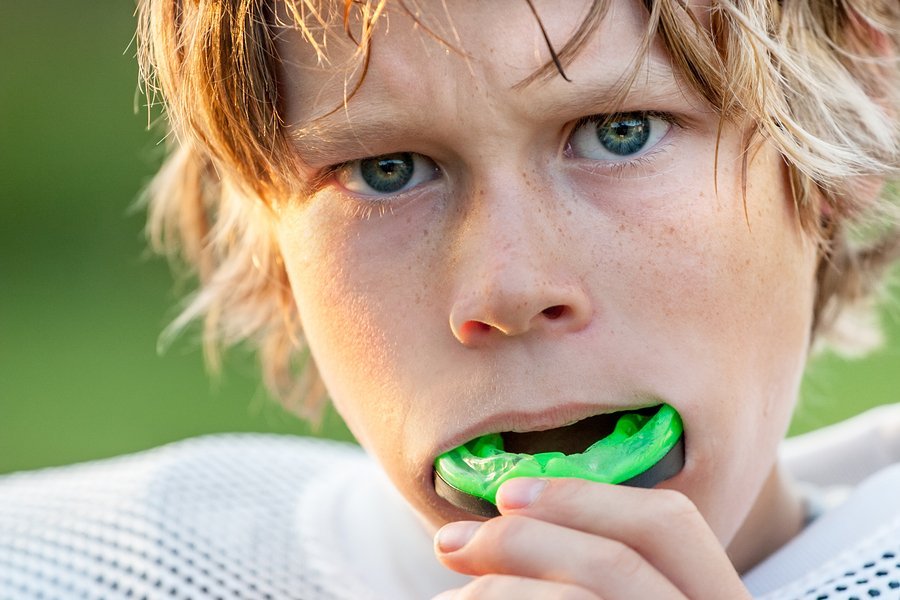Countless children participate in soccer, baseball, football, hockey and other youth sports. Unfortunately, while they can be especially rewarding, these activities do come with some risk. If you are the parent of a young athlete, here’s what you should know about mouthguards.
What Is the Risk?
Because they involve close contact with other athletes, youth sports come with some inherent risk. According to the Centers for Disease Control and Prevention, recreational activities, including sports, account for over three million visits to emergency rooms every year for kids between the ages of 5 and 14. The CDC reports that sports-related injuries are also the leading cause of ER visits in 12 to 17 year olds.
Injuries can range from minor abrasions to lacerations, broken bones and concussions. For many kids, however, sports injuries result in lost or damaged teeth. The National Youth Sports Safety Foundation (NYSSF) reports that 3 million teeth are knocked out during youth sporting events every single year. While it may not be possible to eliminate every one of these incidents, experts have shown that athletic mouthguards can go a long way toward offering reliable protection.
What Is a Sports MouthGuard?
Sometimes called sportsguards, mouthguards are soft plastic or laminate devices used to protect against oral injuries to the mouth, teeth, cheeks, jaw and tongue. They are available as generic devices or can be custom made by dental professionals to better fit a young athlete’s mouth.
Whatever the case, a good mouthguard can help protect against common issues that occur during popular sports:
- Mouthguards for football and soccer: Help to protect against oral issues related to jarring blows; some evidence suggests protection against concussions
- Mouthguards for basketball: Protect teeth from accidental collisions with elbows and falls to the floor
- Mouthguards for baseball: Protect against dental injuries sustained due to errant throws and contact with a bat or base-runner
- Mouthguards for hockey: Help to protect teeth from pucks, hockey sticks and collisions with walls and other players
For sports where complete facial protection is worn, such as football, hockey or men’s lacrosse, a mouthguard with a thin frontal profile can help protect against collisions affecting the upper and lower jaws. For non-contact sports, such as basketball and soccer, athletes actually need more protection, since they don’t wear protective headgear.
While mouthguards tend to be similar regardless of the sport, some teams and organizations have specific requirements. Be sure to check with your coach, league office and dentist if you aren’t sure which type of device to purchase.
Why Is Wearing a Sports Mouthguard Important?
According to the American Dental Association (ADA), athletes are 60 times more likely to endure some type of dental injury if they do not wear a mouthguard. There is also some compelling evidence that mouthguards could protect against concussions.
Since they have been shown to offer proven protection against oral injuries, mouthguards are often required by coaches and youth athletic organizations. That said, these devices tend to work best when they comfortably conform to a child’s unique oral structure.
Choosing the Right Mouthguard
While generic mouthguards are available at most sporting goods stores, many people choose custom-made devices, specifically designed to fit comfortably and securely within a child’s mouth. This is especially true when children have braces, which can increase the risk of injury for the child and other athletes.
Many times, off-the-shelf mouthguards won’t leave enough room for braces or are too loose to offer enough protection. In turn, many parents ask their orthodontists or general dentists to design custom devices that better protect their children’s mouths, teeth and braces. While these can be more expensive, the cost is considerably low when compared to the costs of repairing dental damage or replacing damaged bridges, crowns or braces.
Some manufacturers also offer wide or “boil-and-bite” mouthguards, however, these don’t always provide optimal protection, depending on the child’s sport and individual oral structure.
The Bottom Line
When choosing the proper type of mouthguard, it’s a good idea to talk to your child’s coach, instructor or league office. In some instances, young athletes are only covered by team insurance if they are wearing mouthguards that are custom-made by a dental professional. Some leagues also require that participants wear double mouthguards, which protect the top and bottom portions of the mouth.



 Previous Article
Previous Article